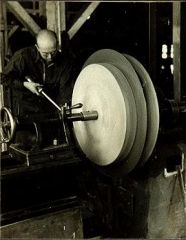-
Posts
2,092 -
Joined
-
Last visited
Content Type
Profiles
Forums
Articles
Gallery
Downloads
Events
Everything posted by Timothy Miller
-

Identifying alloy steel with spark testing is a myth today
Timothy Miller replied to ciladog's topic in Metallurgy
I have had some success identifying unknown steel against known samples by sparking it side by side on a wide grinding wheel. It is tricky thing there are so many alloys out there. I usually combine it with a quench and fracture test and see what it normalizes like. Some steels will get too hard to cut or drill as forged others will not. It is a useful skill to cultivate but not definitive. -

Forge able stainless alloys???
Timothy Miller replied to FieryFurnace's topic in Blacksmithing, General Discussion
316 stainless is more corrosion resistant than 304 and more expensive. Both are hard to forge 304 is the most easy to find. -

When is it appropriate to Forge Weld?
Timothy Miller replied to George Geist's topic in Blacksmithing, General Discussion
It is appropriate to forge weld when ever the smith deems so. It is mostly done when it is historically correct, fun or the quickest way to get the job done. Once you get good at it its not that big of a deal to do it. One should not build it up into some mystical thing or put it in a special box that only gets opened when planets align. It should be a normal natural thing that happens in the course of a project when it makes sense. If it never makes sense for you than you are missing a big part of what it is to be a blacksmith. -

looking for wrought iron
Timothy Miller replied to WraithsNinja's topic in Blacksmithing, General Discussion
What I should have said is the place in "The real wrought iron company" England is the only place where you can call up and order a size and they will be able to make it for you. Everybody else has scrap only of a few sizes. -

looking for wrought iron
Timothy Miller replied to WraithsNinja's topic in Blacksmithing, General Discussion
They do make ultra low carbon steel called univit steel. It is very easy to form and more forgiving than wrought iron it does come in large sheets. Wrought iron is not really made anymore it can really only be found as rerolled scrap from England. -

Matching Brushed nickel hardware????
Timothy Miller replied to FieryFurnace's topic in Blacksmithing, General Discussion
Dave's design could be executed in stainless steel. -

Matching Brushed nickel hardware????
Timothy Miller replied to FieryFurnace's topic in Blacksmithing, General Discussion
I only have small scraps on hand I will look around and see what if anything I have that I can part with. It tends to forge harder than copper it has a wide forging range stop short of yellow or it cracks and is a bit softer than steel. You can do a good amount of cold work to it as well. -

Matching Brushed nickel hardware????
Timothy Miller replied to FieryFurnace's topic in Blacksmithing, General Discussion
Stainless steel is very hard to forge, it can split easily when it is forged too cold. It is also it is hard to do detailed work in stainless steel. I have lots of professional experience forging stainless steel I am not speculating here or parroting the words of others. I much prefer to forge copper/nickel ihttp://www.farmerscopper.com/copper-nickel-715-c715-c71500.html. It is more expensive but you will make up on the labor in a small piece, It actually contains nickel so you are giving the client the real deal and that's what we as smiths supply the real deal not substitutions. Plating makes chemicals you have to dispose of and that can get pricey. I would make a finish sample regardless of witch way you go. Do this before you take any cash from your client so you are not on the hook to make something that you are going to loose money on or don't currently have the experience to execute professionally. -

Fixing a small leg vise with a broken screw
Timothy Miller replied to Timothy Miller's topic in Vises
I have spent many an hour at my old south bend lathe. After forging lathe work is my second love. There is something about a spinning work piece and trimming away metal slowly with a sharp bit of metal that really appeals to me that I find meditative. This is today's effort, I finished up the turning, rough forged the dove tail and began filing it to shape. The dove tail is much longer than it needs to be at this point. Next step will be to trim it and fit it to the remainder of the screw. -

Matching Brushed nickel hardware????
Timothy Miller replied to FieryFurnace's topic in Blacksmithing, General Discussion
Forge it from Monell or 70/30 cupro/nickel -

Safe Iron Stock ID
Timothy Miller replied to Jean- Sebastian's topic in Blacksmithing, General Discussion
Rusty is probably OK stop at the first sign of white or yellow colored smoke, odd colored flames or funny smells. -

Fixing a small leg vise with a broken screw
Timothy Miller replied to Timothy Miller's topic in Vises
Dan to give my self a break on a tough job I did it all in wrought iron. Today I chucked it up in the lathe and got it rough turned. It was rough going at first because it was about 5/16" out of round and full of lumps. This is a result of me having too much metal in the scarf and hand hammering. But this is how you learn. A set of dies would have helped to make the part more concentric and saved a bunch of time in forging and turning. Next step will be to further refine and smooth the shape then add decorative details. -
I think they beefed up an old skinny vise with some extra iron for heavy duty use. You can see where they forge welded on some extra iron. Probably the box and screw wore out and a frugal smith decided to resurrect it. It is a testament to the ingenuity of craftsman working with whats at hand. Its an 18th century vise and probably a 19th century repair.
-

First try at a bearded axe
Timothy Miller replied to Matthew Paul's topic in Axes, Hatchets, Hawks, Choppers, etc
Nice job you are ready to start your own raiding party. :) -

What makes a metal bandsaw a metal bandsaw?
Timothy Miller replied to Gundog48's topic in Saws, bandsaws, hack saws, etc
Portable band saws are considered a must have among professional metal workers in the US. Here I can often find good deals on used horizontal metal cutting band saws. Metal cutting saws are generally built to be much more rigid to withstand the higher pressures and torque involved. A good saw in the shop is an investment not an expense. -
bolts are cheap, post pictures of the vise we can help.
-

Fixing a small leg vise with a broken screw
Timothy Miller replied to Timothy Miller's topic in Vises
I will keep that in mind Doc, it will probably be stronger as well. It has been my plan all along to forge braze it. This is tonight's effort First photo shows the collar prior to forge welding. The second shows collar in place and fluxed. Third shows the finished weld. This project would have been a lot easier with swage to form the the ball and collar but I am only making one. I am fairly sure that the peter wright factory had some form of swage to forge this part. Next step will be to take it to the lathe and refine the shape. I have a bunch of excess material here but I did that on purpose because I was not sure how the forge welding would play out. I wanted to finished part to took look like it was original to the vise. I have two other peter wright vise screws to use as a model strangely they are both different but both beautifully turned with nice decorative details. -

500 pound fisher anvil, what would you pay?
Timothy Miller replied to marcusb's topic in Anvils, Swage Blocks, and Mandrels
I has a 500 lib fisher with some torch damage on the edges but not much wear. I put it up on ebay could not sell it for 900 wound up trading it for a iron worker and with some other tools. -

500 pound fisher anvil, what would you pay?
Timothy Miller replied to marcusb's topic in Anvils, Swage Blocks, and Mandrels
I seriously doubt a man of your age has no sediment. :D -

Fixing a small leg vise with a broken screw
Timothy Miller replied to Timothy Miller's topic in Vises
Yes I plan on doing a socket and tenon joint for the forge brazed joint. I am tiring to share some advanced level stuff to inspire us all. -
This is a weird one I have seen many broken vices but never one like this. It was such a shapely little vise I felt it need to be saved. The handle end of the screw sheared off and was lost. I decided to try to fix purely by forging to stretch my skills and learn more about different how things can be built up by forge welding. I still have all of the thread. I faced off the rough end of the thread in the lathe. I decided to try to make a new handle end out of wrought iron like the older screws were were done. I started by wrapping a collar of wrought iron around a 1" bar of wrought iron. I then forged some 1 1/2" half round in a bottom swage and wrapped a collar for the ball end. It took about 4 or 5 heats to close up the weld seems and round it up properly. My next step will to weld the collar that bears up around the front jaw then clean it up on my lathe. I will then forge braze it to the remainder of the old screw. The ball will be cross drilled and a new handle installed. I will post more photos as I progress.
-
Where are you located? I have lots of good logs. You can use a wide strip of something flexible with a straight edge and wrap it around the log just make sure you can go more than one wrap so you can see that it is straight all the way around then mark it with chalk and cut.

